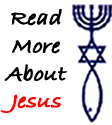






![]()
![]() Soon after God called Abraham, before He actually made the covenant with him, God introduced him to Melchizedek, a priest of a higher order then the one that would come from Abraham's descendants. The Messiah Himself was referred to in Hebrews 5:6 in this passage, “You are a priest forever According to the order of Melchizedek.” There are reasons why the Messiah's Priesthood Is Better Than Melchizedek's. Later in Israel's history after God gave Israel the torah on Mt. Sinai, Aaron became the first High Priest under the law. That was the beginning of what is referred to as the Levitical Priesthood since all descendents of the High Priest office were to be from Aaron's bloodline.
Soon after God called Abraham, before He actually made the covenant with him, God introduced him to Melchizedek, a priest of a higher order then the one that would come from Abraham's descendants. The Messiah Himself was referred to in Hebrews 5:6 in this passage, “You are a priest forever According to the order of Melchizedek.” There are reasons why the Messiah's Priesthood Is Better Than Melchizedek's. Later in Israel's history after God gave Israel the torah on Mt. Sinai, Aaron became the first High Priest under the law. That was the beginning of what is referred to as the Levitical Priesthood since all descendents of the High Priest office were to be from Aaron's bloodline.
Before Antiochus' campaign against Egypt, there had been turmoil in Jerusalem concerning the office of high priest. Josephus (Ant. X11 5, 1) tells us that when Onias (the Hellenized form of Chonio) the High Priest died, his son was too young to succeed him. Yeshua, brother of Onias, who changed his name to the Greek "Jason" was appointed to the post. The king, because of his anger (Josephus does not give the reason for his anger) against Jason, appointed his younger brother, also (strangely) named Onias, who then changed his name to Menelaus.(1)
Other sources reveal that Yeshua (Jason) offered Antiochus an exorbitant bribe to appoint him high priest. After having served in this post for some time, Menelaus (according to this source not a brother of Yeshua, nor even a kohen of the priestly family) promised the king an even greater sum, and was promptly given the post. Both these nominees had promised the king their utmost cooperation to enforce the king's pet project of Hellenizing the country, by forcibly spreading Greek culture.(2)
Annas was not the current high priest, having been disposed by the Romans in favor of his son-in-law Caiaphas. He still bore the title of high priest, just as ex-presidents of the United States are still called president. Caiaphas was in office until 36 A.D. He was a Sadducee. (Sadducees believed only in the first five books of Moses, since they did not recognize the prophets they did not believe in a resurrection).(2) (Note concerning Book of Acts Chapter 4 Verse 6).
The High Priest ruled over the temple. He was appointed by Herod for the duration he desired, and often won his office through treachery or bribery. Beginning with the Maccabean revolt and up until the time of Herod-the high priest was the leading religious and political figure in Jerusalem.(3)
After Herod's death and the removal of Archelaus, the appointing of the high priest passed to the Roman governors of Jerusalem.(3)
For 44 years following the reign of Herod, the Romans usurped the right of appointing the High Priest. The right reverted to King Agrippa the second during the last 20 years of the temples existence.(3) In the final generation of high priests prior to 70 A.D. (Temple's destruction), the Roman Governors once again allowed Agrippa 2nd to choose the high priest.(3)
A man who served as a priest did so because he was born into the right family, (Descendant of Aaron, tribe of Levi) not necessarily because he lived a right life. A priest served from the age of 25, was officially a priest with all duties at age 30 and served until the age of 50, after which his ministry was over (Num. 8:24-25).
Although all priests were commanded to be levite's not all Levite's were priests.
The Book of Maccabees also mentions corruption in the office of High Priests.
The priest that were chosen were usually from wealthy families. This is because sometimes there was bidding for the position and the highest bidder would win the position of high priest.(3)
It is believed that the High Priests in the era of Jesus were all Sadducees (as oppose to Pharisees). Sadducees did not recognize the Prophets as being the authoritive work from God even though the Pharisees did. Therefore they did not believe in things like the timing of the coming of the Messiah found in Daniel 9:24-27 or the Suffering Servant found in Isaiah 53 or even a bodily resurrection to come later. The High Priest was also the president of the San Hedrin, the same court that refused to recognize Jesus as Israel's Messiah.
Interestingly, one of the signs that Israel was to be forgiven, when represented by her High Priest on the Day of Atonement was that they would tie a scarlet thread where it could be observed, at the start of the holiday and by the end of the day the scarlet thread would change in color from scarlet to white, showing all Israel her sins had been forgiven.
For forty years before the destruction of the temple the thread of scarlet never turned white but it remained red. Talmud- Mas. Rosh HaShana 31b
Other articles of interest include:
1). ArtScroll commentary on the Book of Daniel p.303.
2). John MacArthur's New Testament Commentary on the Book of Acts p.132.
3). The Fall Feast of Israel by Mitch and Zhava Glaser.